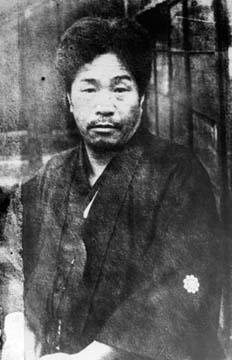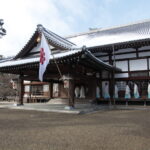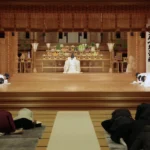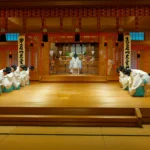By Ruth Reiner
So, I guess you survived my metaphor mood last week, and you’re back to hear some more of what was going on at the time of the “First Oomoto Persecution”.
In last week’s item the police took over Oomoto grounds, eagerly searching for evidence of all the incredible horrors, which the press had led the public to believe about Oomoto. Shortly after taking over the Oomoto grounds, the police went to arrest Onisaburo at the newspaper office where he was at the time. They charged him with le’se-majeste’. As I mentioned before, this was the worst charge at that time!
After about two months as the investigations ended, all newspapers in the country issued two pages of malicious, unbelievably fabricated articles, such as:
“Exposed – all the secrets of jugglery by which Oomoto was deceiving society and making fools out of it’s believers” (Osaka Mainichi), “Search of the secret underground chambers at the risk of life – are the unmoving black things corpses? Horrors!” (Osaka Asahi) ect… (Ch 16, “The Great Onisaburo Deguchi”)
I bet the newspapers did good business at that time. But the Kyoto District Court final charges against Oomoto were, lese’ majest’e and contravention of Press Act against Onisaburo and Asano. I guess the Press could not totally get away with these false accusations. (Mr. Kyotaro Deguchi, the writer of the book, finds it only fair to mention those from the press who were trying all along to remain objective. (Please see ch. 17) )
The book states that actually “Oomoto was relatively calm in the face of this tidal wave of oppression”, and that Onisaburo’s imprisonment, too, was only seen as a fulfillment of prophecies that were made long before by Nao Deguchi, the foundress, and by Onisaburo himself. (ch 17)

But as calm as the Oomoto leaders were, the outcomes were not easy. Onisaburo was sentenced to five years’ imprisonment for le’se-majeste’, and Asano for ten months. The evening before the trail took place, September 15, 1921, Onisaburo said to the Osaka Asahi News:
”It comes to me as a complete surprise that we, who revere the gods and love our fatherland, have been charged with le’se-majeste’. It is said that people who swim a lot often drown, and we seem to have suffered from the bulk of our writings in just the same way. One day this affair will be understood.” (ch 17)
At first Onisaburo was held one hundred and twenty six days in prison until he was granted bail. Then came the “public” hearing that was actually denied to the public. The matters related to the case were kept top secret, but leaked to the newspapers as many to “secret” cases (this I mention as an Israeli, since everything in Israel is secret and yet everything always leaks…). The rumors spread, that soon the Oomoto sanctuaries would be destroyed…
And so it was. Orders eventually came to destroy the Oomoto sanctuaries on the hill of Honguyama (for all you that have visited Oomoto, this is near where the Choseiden in Ayabe is today). It was emphasized that these buildings too resembled the Grand Shrine of Ise, that is, the ancestral shrine of the Imperial Family. Yah, as Mr. Kyotaro Deguchi, the writer, mentions next in the book, all Japanese shrines resemble one another… But from this miserable accusation we can learn today about the spirit at that time.
And so, on October 18, 1921, Oomoto held a farewell ceremony for the Honguyama sanctuaries which were to be destroyed, by a great demonstration of military power “3,500 Army Reserves in a Show of force”, as the newspapers of that time reported. (ch 17)
Then the second verdict was handed down, and again Onisaburo was sentenced to five years in prison. Oomoto had no intention to accept the sentence and the serious charges, and so the case was finally brought before the supreme court.
And at this point in the book, I read something I could not understand. So I turned to Mr. Tanaka, who sits near me in the office and always has wonderful answers even to the most ignorant questions I could find. So the thing I could not figure, was that the story continues and says that at some point as the case was reviewed in front of the supreme court, the Emperor died, and so the case was dismissed. Well, so as Mr. Tanaka explained to me, that is a Japanese tradition. When Emperors die, some prisoners are excused…
In all, this incredible case lasted over six years, till finally Onisaburo was cleared of the charges brought against him… Although finally the case was dismissed, it is hard to say that Oomoto had not suffered by then already too much.
But as we will see later on, this “incident” was just the appetizer. And as Oomoto struggles to survive these miserable times, it reacts and reshapes itself quite uniquely, maybe, due much to this special man Onisaburo Deguchi. This and more I would like to discuss with you on the next weekly item on the book “The Great Onisaburo Deguchi”.



